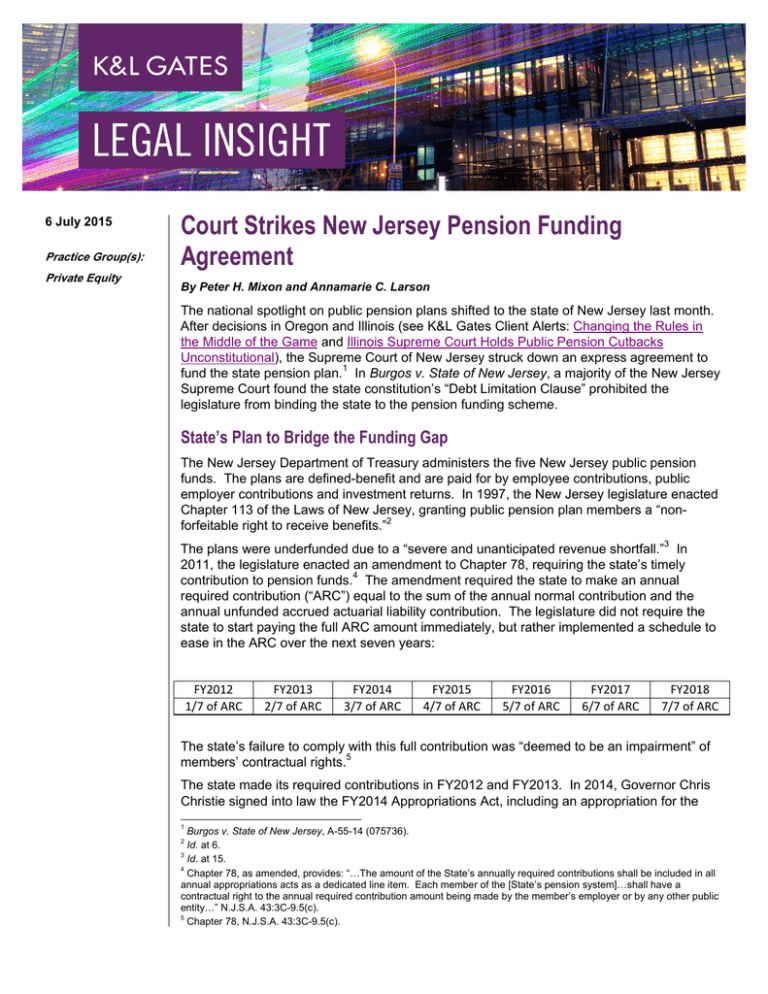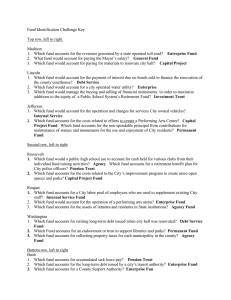
6 July 2015
Practice Group(s):
Private Equity
Court Strikes New Jersey Pension Funding
Agreement
By Peter H. Mixon and Annamarie C. Larson
The national spotlight on public pension plans shifted to the state of New Jersey last month.
After decisions in Oregon and Illinois (see K&L Gates Client Alerts: Changing the Rules in
the Middle of the Game and Illinois Supreme Court Holds Public Pension Cutbacks
Unconstitutional), the Supreme Court of New Jersey struck down an express agreement to
fund the state pension plan.1 In Burgos v. State of New Jersey, a majority of the New Jersey
Supreme Court found the state constitution’s “Debt Limitation Clause” prohibited the
legislature from binding the state to the pension funding scheme.
State’s Plan to Bridge the Funding Gap
The New Jersey Department of Treasury administers the five New Jersey public pension
funds. The plans are defined-benefit and are paid for by employee contributions, public
employer contributions and investment returns. In 1997, the New Jersey legislature enacted
Chapter 113 of the Laws of New Jersey, granting public pension plan members a “nonforfeitable right to receive benefits.”2
The plans were underfunded due to a “severe and unanticipated revenue shortfall.”3 In
2011, the legislature enacted an amendment to Chapter 78, requiring the state’s timely
contribution to pension funds.4 The amendment required the state to make an annual
required contribution (“ARC”) equal to the sum of the annual normal contribution and the
annual unfunded accrued actuarial liability contribution. The legislature did not require the
state to start paying the full ARC amount immediately, but rather implemented a schedule to
ease in the ARC over the next seven years:
FY2012
1/7 of ARC
FY2013
2/7 of ARC
FY2014
3/7 of ARC
FY2015
4/7 of ARC
FY2016
5/7 of ARC
FY2017
6/7 of ARC
FY2018
7/7 of ARC
The state’s failure to comply with this full contribution was “deemed to be an impairment” of
members’ contractual rights.5
The state made its required contributions in FY2012 and FY2013. In 2014, Governor Chris
Christie signed into law the FY2014 Appropriations Act, including an appropriation for the
1
Burgos v. State of New Jersey, A-55-14 (075736).
Id. at 6.
3
Id. at 15.
4
Chapter 78, as amended, provides: “…The amount of the State’s annually required contributions shall be included in all
annual appropriations acts as a dedicated line item. Each member of the [State’s pension system]…shall have a
contractual right to the annual required contribution amount being made by the member’s employer or by any other public
entity…” N.J.S.A. 43:3C-9.5(c).
5
Chapter 78, N.J.S.A. 43:3C-9.5(c).
2
Court Strikes New Jersey Pension Funding Agreement
state’s full required contribution for that year. On May 20, 2014, Governor Christie issued an
executive order reducing the payments for FY2014. Plan members and unions filed
complaints, but the Law Division upheld the governor’s determination.
In 2015, the FY2015 Appropriations Bill included an appropriation for the state’s full required
contribution for that year. The governor exercised his line-item veto power to delete the
pension payment. Plan members and unions amended their complaints, and the trial court
granted them summary judgment. The state appealed to the Supreme Court of New Jersey.
No Contract Existed
The court first acknowledged that the New Jersey and United States Constitutions prohibit
the passage of laws impairing the obligation of contracts.6 Although the legislature spoke
with intent to create a contract, it lacked authority to enter into such a contract because it
acted contrary to other constitutional provisions, specifically the Debt Limitation Clause.
Under the New Jersey Constitution, the power and authority to appropriate funds is vested in
the Legislature.7 The Debt Limitation Clause of the of the New Jersey Constitution was
adopted in 1844 and provides: “The Legislature shall not, in any manner, create…debt or
debts, liability or liabilities of the State, which…shall exceed at any time one per centum of
the total amount appropriated…for that fiscal year[.]” The clause excepts laws that have
been approved by the people at a general election.
The majority’s reasoning hinged on defining the pension funding obligation as a “debt,” one
which exceeded 1 percent of total appropriations for the fiscal year and had not been
approved by the people in a general election. Because the pension contribution scheme in
Chapter 78 violated the Debt Limitation Clause, the legislature had no authority to pass such
contractual rights. As the majority explained, it is not a clash of constitutional provisions (the
Debt Limitation Clause and the Contracts Clause), because there was no contract in the first
place. “Chapter 78’s contractual language creates, at best, the equivalent of appropriationsbacked debt that is accompanied by a strong legislative expression of intent to provide future
funding.”8
The majority emphasized that the judiciary has no authority in the budgetary process. Citing
City of Camden, the court suggested that even if a statute conferred substantive rights, it
would “in no way diminish[ ] the Legislature’s constitutional control over the state fisc.”9
Illinois Case Distinguished
In a footnote, the majority explained that Illinois lawmakers clearly created a substantive
constitutional right that could not be diminished, and “diminution in benefits was the issue
before the court, not a purported right to a specific funding scheme.”10 Although the Illinois
Constitution does contain a “State Debt” clause, In re Pension Reform Litigation was different
because the legislation in question reduced members’ benefits. The New Jersey legislation
did not reduce benefits; rather, the challenged statutes purportedly bound the state into
paying its contribution to the plan.
6
Burgos at 23.
Id. at 42.
8
Id. at 9.
9
Id. at 47 (citing City of Camden v. Byrne, 82 N.J. 133, 148 (1980)).
10
Id. at 29 n.4.
7
2
Court Strikes New Jersey Pension Funding Agreement
Dissent: Pension Obligation is Not a Debt
Chief Justice Rabner’s dissent explains, “Never before until today, has the Debt Limitation
Clause been applied to the ordinary operating expenses of government, such as deferred
compensation earned by public workers and payable as pension benefits.”11 Because the
Debt Limitation Clause was not implicated, the justice opined, the legislature’s enactment of
Chapter 78 was valid and a contract exists. “[T]he State must have known that Chapter 78
was in compliance with [the Debt Limitation Clause and Appropriations Clause] when passed
by the Legislature and signed by the Governor.”12
Conclusion
The court’s use of the Debt Limitation Clause to invalidate an “agreement” to fund the
pension plan is a novel decision. Although other state constitutions contain debt limitation
provisions, accrued unfunded liabilities are typically not considered a “debt.” The court noted
that it did not consider the pension members’ contract rights to benefits and the decision did
not reduce them. But without adequate funding, the security of the members’ benefits is
certainly in question. This case suggests that the members’ rights to an adequately funded
pension plan might need to be found inherent in their constitutional rights to a pension. This
case also calls into question other transactions the state entered into after the 1844 adoption
of the Debt Limitation Clause; if a transaction created debt of more than 1 percent total
appropriations and was not approved in a general election, it may be challenged as violating
the Debt Limitation Clause.
Authors:
Peter H. Mixon
Peter.Mixon@klgates.com
+1.206.370.7802
Annamarie C. Larson
Annamarie.Larson@klgates.com
+1.206.370.8013
11
12
Burgos v. State of New Jersey, A-55-14 (Rabner, C.J., dissenting) (emphasis added).
Id. at 25.
3
Court Strikes New Jersey Pension Funding Agreement
Anchorage Austin Beijing Berlin Boston Brisbane Brussels Charleston Charlotte Chicago Dallas Doha Dubai Fort Worth Frankfurt
Harrisburg Hong Kong Houston London Los Angeles Melbourne Miami Milan Moscow Newark New York Orange County Palo Alto Paris
Perth Pittsburgh Portland Raleigh Research Triangle Park San Francisco São Paulo Seattle Seoul Shanghai Singapore Spokane
Sydney Taipei Tokyo Warsaw Washington, D.C. Wilmington
K&L Gates comprises more than 2,000 lawyers globally who practice in fully integrated offices located on five
continents. The firm represents leading multinational corporations, growth and middle-market companies, capital
markets participants and entrepreneurs in every major industry group as well as public sector entities, educational
institutions, philanthropic organizations and individuals. For more information about K&L Gates or its locations,
practices and registrations, visit www.klgates.com.
This publication is for informational purposes and does not contain or convey legal advice. The information herein should not be used or relied upon in
regard to any particular facts or circumstances without first consulting a lawyer.
© 2015 K&L Gates LLP. All Rights Reserved.
4



